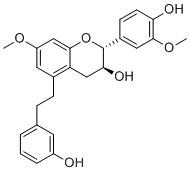Shanciol BCAS# 208106-53-0 |

Quality Control & MSDS
Package In Stock
Number of papers citing our products

| Cas No. | 208106-53-0 | SDF | Download SDF |
| PubChem ID | N/A | Appearance | Powder |
| Formula | C25H26O6 | M.Wt | 422.5 |
| Type of Compound | Flavonoids | Storage | Desiccate at -20°C |
| Solubility | Soluble in Chloroform,Dichloromethane,Ethyl Acetate,DMSO,Acetone,etc. | ||
| General tips | For obtaining a higher solubility , please warm the tube at 37 ℃ and shake it in the ultrasonic bath for a while.Stock solution can be stored below -20℃ for several months. We recommend that you prepare and use the solution on the same day. However, if the test schedule requires, the stock solutions can be prepared in advance, and the stock solution must be sealed and stored below -20℃. In general, the stock solution can be kept for several months. Before use, we recommend that you leave the vial at room temperature for at least an hour before opening it. |
||
| About Packaging | 1. The packaging of the product may be reversed during transportation, cause the high purity compounds to adhere to the neck or cap of the vial.Take the vail out of its packaging and shake gently until the compounds fall to the bottom of the vial. 2. For liquid products, please centrifuge at 500xg to gather the liquid to the bottom of the vial. 3. Try to avoid loss or contamination during the experiment. |
||
| Shipping Condition | Packaging according to customer requirements(5mg, 10mg, 20mg and more). Ship via FedEx, DHL, UPS, EMS or other couriers with RT, or blue ice upon request. | ||

Shanciol B Dilution Calculator

Shanciol B Molarity Calculator
| 1 mg | 5 mg | 10 mg | 20 mg | 25 mg | |
| 1 mM | 2.3669 mL | 11.8343 mL | 23.6686 mL | 47.3373 mL | 59.1716 mL |
| 5 mM | 0.4734 mL | 2.3669 mL | 4.7337 mL | 9.4675 mL | 11.8343 mL |
| 10 mM | 0.2367 mL | 1.1834 mL | 2.3669 mL | 4.7337 mL | 5.9172 mL |
| 50 mM | 0.0473 mL | 0.2367 mL | 0.4734 mL | 0.9467 mL | 1.1834 mL |
| 100 mM | 0.0237 mL | 0.1183 mL | 0.2367 mL | 0.4734 mL | 0.5917 mL |
| * Note: If you are in the process of experiment, it's necessary to make the dilution ratios of the samples. The dilution data above is only for reference. Normally, it's can get a better solubility within lower of Concentrations. | |||||

Calcutta University

University of Minnesota

University of Maryland School of Medicine

University of Illinois at Chicago

The Ohio State University

University of Zurich

Harvard University

Colorado State University

Auburn University

Yale University

Worcester Polytechnic Institute

Washington State University

Stanford University

University of Leipzig

Universidade da Beira Interior

The Institute of Cancer Research

Heidelberg University

University of Amsterdam

University of Auckland

TsingHua University

The University of Michigan

Miami University

DRURY University

Jilin University

Fudan University

Wuhan University

Sun Yat-sen University

Universite de Paris

Deemed University

Auckland University

The University of Tokyo

Korea University
- 5,6-Dihydroxy-7,8-dimethoxyflavone
Catalog No.:BCN0701
CAS No.:76844-65-0
- Delicaflavone
Catalog No.:BCN0700
CAS No.:343569-15-3
- Luteolin 5-methyl ether
Catalog No.:BCN0699
CAS No.:58115-29-0
- Violanone
Catalog No.:BCN0698
CAS No.:52250-38-1
- Luteolin 5,3'-dimethyl ether
Catalog No.:BCN0697
CAS No.:62346-14-9
- (2S)-Pinocembrin 7-O-[2''-O-(5'''-O-trans-cinnamoyl)-β-D-apiofuranosyl]-β-D-glucoside
Catalog No.:BCN0696
CAS No.:773899-29-9
- Kayaflavone
Catalog No.:BCN0695
CAS No.:481-45-8
- E,Z-Platanoside
Catalog No.:BCN0694
CAS No.:1197343-17-1
- Quercetin 4'-O-galactoside
Catalog No.:BCN0693
CAS No.:381728-34-3
- Tamarixin
Catalog No.:BCN0692
CAS No.:27542-39-8
- Morelloflavone
Catalog No.:BCN0691
CAS No.:16851-21-1
- Platanoside
Catalog No.:BCN0690
CAS No.:133740-25-7
- Ochnaflavone
Catalog No.:BCN0703
CAS No.:50276-96-5
- 3',3'''-Biapigenin
Catalog No.:BCN0704
CAS No.:151455-26-4
- Chrysocauloflavone I
Catalog No.:BCN0705
CAS No.:899789-51-6
- 6,7,4'-Trihydroxyflavanone
Catalog No.:BCN0706
CAS No.:189689-31-4
- Procyanidin B2 3,3'-di-O-gallate
Catalog No.:BCN0707
CAS No.:79907-44-1
- 2'',3''-Dihydro-3',3'''-biapigenin
Catalog No.:BCN0708
CAS No.:151455-25-3
- 3',3'''-Binaringenin
Catalog No.:BCN0709
CAS No.:145399-99-1
- 2'',3''-Dihydroochnaflavone
Catalog No.:BCN0710
CAS No.:340997-02-6
- Procyanidin B5
Catalog No.:BCN0711
CAS No.:12798-57-1
- Procyanidin B2 3''-O-gallate
Catalog No.:BCN0712
CAS No.:73086-04-1
- 2"-O-Glucosylrutin
Catalog No.:BCN0713
CAS No.:55696-55-4
- 2,3-Dihydroamentoflavone
Catalog No.:BCN0714
CAS No.:34340-51-7
New phenanthrene derivatives with nitric oxide inhibitory and radical-scavenging activities from Pholidota imbricata Hook.[Pubmed:24128147]
Nat Prod Res. 2014;28(4):251-6.
One new phenanthrene derivative phoimbrtol A (1) with seven known compounds, loddigesiinol B (2), Shanciol B (3), (-)-medioresinol (4), (-)-pinoresinol (5), quercetin 3-O-beta-L-arabinofuranoside (6), luteolin 7-O-beta-glucoside (7) and platycaryanin D (8) have been isolated from the ethyl acetate extract of the air-dried whole plant of Pholidota imbricata Hook. Their inhibitory effects on nitric oxide (NO) production and 1,1-diphenyl-2-picrylhydrazil (DPPH) radical scavenging activity were examined. Among these compounds, 8 exhibited the most potent activity at NO production inhibitory assay and DPPH radical scavenging assay, stronger than those of the familiar antioxidative agents, quercetin and resveratrol.
Investigation into potent inflammation inhibitors from traditional Chinese medicine.[Pubmed:21801310]
Chem Biol Drug Des. 2011 Oct;78(4):679-88.
Microsomal prostaglandin E synthase-1 (mPGES-1) is the key enzyme for prostaglandin E2 (PGE2) generation during inflammation and is a potential target for designing anti-inflammatory drugs. Potential inhibitors of m-PGES-1 were selected from traditional Chinese medicine (TCM Database@Taiwan) based on the pharmacophore map generated by the top HypoGen hypothesis and validated using structure- and ligand-based analysis. Key features for potential m-PGES-1 inhibitors include pi-interactions and H-bond donors. TCM compounds, Shanciol B, shanciol A, castilliferol, and aurantiamide acetate, contoured to the quantitative structure-activity relationship pharmacophore and exhibited high docking scores and binding stability with m-PGES-1. Bioactivity models multiple linear regression (MLR) and support vector machine also supported activity predictions for the candidate compounds. Our results indicate that the investigated TCM compounds could be of use for development into mPGES-1 inhibitors.


